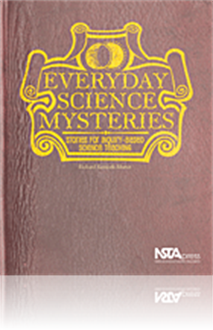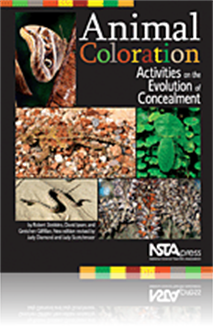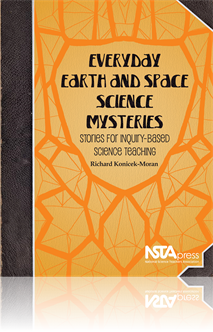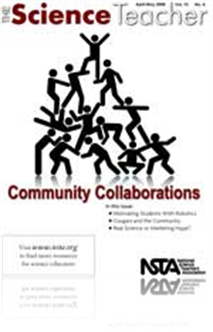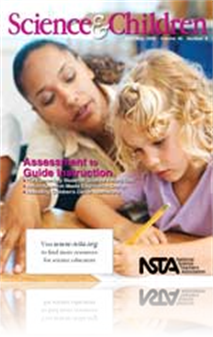All Resources
Book Chapter
This story is aimed at promoting not only inquiry into the germination of tree seeds but seeing trees as typical flowering plants, also known as angiosperms. There is also ample opportunity to take an excursion into fruits and seeds and the germinati...
Book Chapter
For this story, the main purpose is to explore the relationship between temperature and pressure of gases but it may spill over into the concepts of floating and density in older children. It also asks questions about gas being a form of matter that ...
Book Chapter
Rolling objects are always fascinating for children. This story gives children an opportunity to find patterns in the process of rolling objects down ramps. Shades of Galileo! Since he was one of the first to actually do investigations by what “nat...
Book Chapter
The main purpose of studying the pendulum in this story is to provide a vehicle for finding and sorting out variables and designing a study for discovering the variable that controls the period (the time for a back and forth swing) of the pendulum. T...
Book Chapter
The Neighborhood Telephone System
This story uses the “tin can” telephone (TCT) as a focus for inquiry into the transmission of sound waves along a medium and also provides an opportunity for kids to try their hand at improving a simple device so that it works better. Students wi...
Book Chapter
Heat and cold are often difficult concepts for children to understand. First, our everyday sloppy language gives them a predisposition to such common misconceptions as cold being a substance that moves from place to place. Our colloquial language oft...
Book Chapter
Using the Book and the Stories
It is often difficult for overburdened teachers to develop lessons or activities that are compatible with the everyday life experiences of their students. A major premise of this book is that if students can see the real-life implications of science ...
Book Chapter
The Link Between Science, Inquiry, and Language Literacy
There is currently a strong effort to combine science and literacy, because a growing body of research stresses the importance of language in learning science. Discussion, argumentation, discourse of all kinds, group consensus, and social interaction...
Book Chapter
The apparent daily motion of the Moon and other celestial objects through the sky is a major science concept. This story is designed to call attention to the changes in position and shape of the Moon over time. Its purpose is to motivate students to ...
Book Chapter
The main purpose of the “Cheeks” story is to get the children to learn something about the behavior of shadows cast by objects in sunlight. Although the story takes liberties with the “thoughts and projections” of Cheeks, one can take it as m...
Book Chapter
This story is designed to spur an inquiry activity about the process of weathering and soil formation. Evidence lies all around us if we look closely enough and ask the right questions. Eddie is helping us by asking some of these questions and the au...
Book Chapter
The theme of the story can be summed up in one word: microclimates. Have you noticed that there are variations among the temperatures broadcasted on your radio or TV and your own thermometer? Have you noticed that there are differences in temperature...
Book Chapter
The incident described in this story actually happened to the author during a camping trip in Everglades National Park years ago. The humidity was fierce but the air cooled down and overnight he awoke to a wet face and wet pillow. This story is desig...
Book Chapter
Just what kinds of characteristics do living things receive from their parents and what kinds of traits do they not? What makes the offspring of any animal or plant have the basic characteristics of the parents? There happen to be a great number of h...
Book Chapter
Evolution and the Functions of Color
The purpose of the first activity is to stimulate students’ interest in the coloration of animals. While students may already be aware that the white coat of the polar bear provides some measure of concealment in the snowy surroundings of the Arcti...
Book Chapter
This activity introduces students to an animal that is to be the subject of much experimentation by them. Because most fish have a relatively simple form and exhibit a wide variety of colors and patterns, they prove to be an excellent animal for expe...
Book Chapter
In their study of animal coloration, the students will be “hiding” animals from themselves. If the students cannot easily spot a fish, they may assume that the fish will be overlooked by another fish or by a preying bird or mammal. If a moth esca...
Book Chapter
This chapter introduces an especially important subject in the concealment of animals—countershading. One observes many animals with colors that match the general color of their usual backgrounds. Many leaf-eating insects appear green, for example,...
Book Chapter
Concealment of Give-Away Parts
The outline of an animal is not the only feature that might give it away. Often some part of it, perhaps its eyes or its legs or its tail, might also be a clue. In this activity, these parts are called giveaway parts. The function of the first activi...
Book Chapter
A previous activity suggested the importance of behavior to an animal with coincident coloration. If the stripe-legged frog fails to fold its legs, the disruptive markings on them lose much of their effectiveness. If, when at rest, a moth with coinci...
Book Chapter
In this activity, students will be asked to review their experiments from the previous chapters. Throughout this book, the students have studied animal coloration through the use of models, rather than by investigating living animals. This activity g...
Book Chapter
The apparent daily motion of the Moon and other celestial objects through the sky is a major science concept. This story is designed to call attention to the changes in position and shape of the Moon over time. Its purpose is to motivate students to ...
Book Chapter
The purpose of this assessment probe is to elicit students’ ideas about the properties of atoms. The probe is designed to determine whether students can distinguish between the microscopic properties of an atom and the macroscopic properties of a s...
Journal Article
Idea Bank: Warming to Global Warming—Sunspots and Sea-Surface Temperature
In the problem-based laboratory activity described here, students evaluate the causality of changes on the solar surface in regard to climate change and warming in Earth’s environment. They use graphing calculators and real-time data from the inter...
Journal Article
Editor’s Note: Windows Into Understanding
In this month’s column, the editor reflects on how teacher programs in the early 1980s gave little attention to assessment. The assumption was that end-of-chapter tests in textbooks and standardized state tests provided a good idea of student under...
Journal Article
The Early Years: First Explorations in Flower Anatomy
Help children explore the idea that there are many different flower shapes, all with the function of forming seeds, by allowing children to dissect flowers after drawing them, using their fingers or plastic picnic knives. As children take apart the f...
Journal Article
Capturing the Sights and Sounds of Aquatic Life
When working with elementary students, one never knows when that moment of “magic” will happen. For the author, an environmentalist who also conducts outreach activities with elementary students, one of the best of these experiences happened duri...
Journal Article
University Partnership to Deliver Statewide Professional Development
Fort Hays State University and Emporia State University partnered with high-needs rural school districts to develop and offer a three-year professional development institute. The statewide institute was planned collaboratively to specifically meet th...
NSTA Press Book
Everyday Science Mysteries: Stories for Inquiry-Based Science Teaching
What causes condensation? Does temperature affect how well a balloon will fly? How do tiny bugs get into oatmeal? Through 15 mystery stories, this book memorably illustrates science concepts for students and reinforces the value of learning science t...
By Richard Konicek-Moran
NSTA Press Book
Animal Coloration: Activities on the Evolution of Concealment
A classic resource for teachers is now back in an updated edition! Using an inductive and experimental approach, Animal Coloration aims to increase students’ awareness of the ways wild organisms are adapted to their environments. Even though the ac...
By Robert Stebbins, David Ipsen, Gretchen L. Gillfillan, Judy Diamond (Revised New Edition), Judy Scotchmoor (Revised New Edition)
Journal Article
Teaching Students to Think Like Scientists During Cooperative Investigations
To help students think like scientists during cooperative science investigations, the author developed the “thinking roles” strategy described in this article. Thinking roles make students responsible for asking certain types of questions during ...



